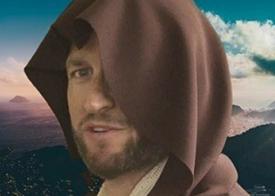Lessons on Conflict Resolution from "Star Wars"


Reaching Far, Far Beyond The Classroom
Perhaps we shouldn’t be surprised that Star Wars has much to teach us about conflict. It’s right there in the title, after all.
As the latest installment of George Lucas’ epic space drama prepares to hit theaters Friday, a Creighton University professor is moving ahead with a book project that aims to use the beloved saga to illustrate key concepts in the field of conflict resolution.

The project, titled Star Wars and Conflict Resolution, will be edited by Noam Ebner, LLM, professor of negotiation and conflict resolution in Creighton’s Graduate School, alongside University of Oregon professor Jen Reynolds. The book will feature chapters written by experts in academia and practice, using narrative elements from the series to introduce important themes in conflict resolution to a general audience.
“The whole world needs this,” says Ebner of the knowledge and skills involved in successfully managing conflict. “If we can somehow hitch the wagon of conflict resolution to the engine of pop culture, we feel we have the potential to reach people far beyond the classroom.”
For Ebner, Star Wars is the perfect vehicle to present these concepts to the masses, and not just because of the franchise’s broad appeal. For one thing, Ebner has been a fan of the series since the very beginning; he saw the first movie, released in 1977, when he was 4 years old.
But the Star Wars films also feature prominent examples of characters dealing with various types of conflict on both a micro and macro scale. In addition to trade wars and legislative disputes, Ebner says, “Star Wars has workplace disputes, and particularly it has family disputes. There’s a little bit of the Skywalker family in every one of our families, and it’s a scary thing if we don’t know how to cope with conflict a little more effectively than the Skywalker family did.”
The book is still in development, with an open call for chapter proposals, Ebner says.
“We want to see what connections people in the conflict field make between Star Wars and conflict, rather than decide these ourselves,” he says. So far, he and Reynolds have been heartened by the enthusiastic response they’ve received from conflict researchers and practitioners who have already submitted.
“You have to have a particular type of nerdy side to you in order to step up to this book in the first place,” Ebner says. “It’s going to be a very sharp and insightful book, but it won’t be a heavy academic tome. It’s intended for a general audience. You have to have a certain playfulness in order to participate.”
A few of the proposals, Ebner says, have centered on the movies’ Jedi Mind Trick, a technique in which Jedi characters use The Force to convince others to comply with their wishes. In real-world conflict negotiation, where the Mind Trick isn’t an option, it’s important to know other tools of negotiation and persuasion.
Other proposals focus on analyzing the movies’ meeting scenes. Each film includes at least one scene in which the major characters huddle to discuss plans for moving forward (often with a hologram of one Death Star or another filling the center of the room). These scenes, Ebner says, include valuable information for how real-world professionals can organize productive meetings, overcoming differences of opinions, negative perceptions or outright hostility.
“It’s fun to play with Star Wars, but this isn’t really about Star Wars. It’s about spreading what we know to anybody who needs it,” Ebner says. “A lot of what we try to do at Creighton is ‘set the world on fire.’ Sometimes you do that with a lightsaber.”